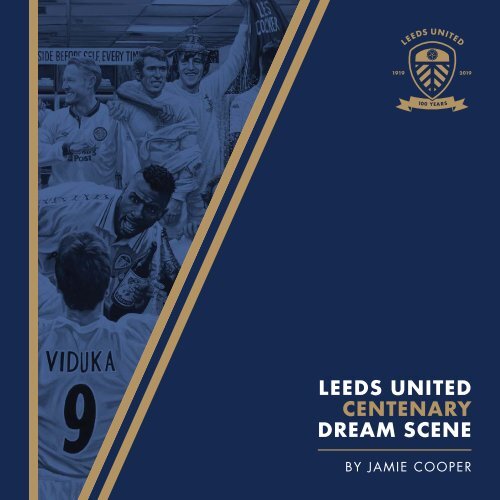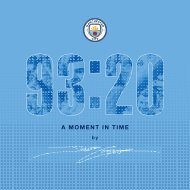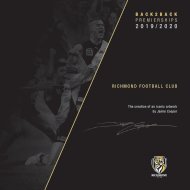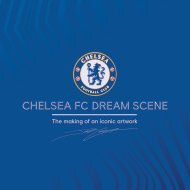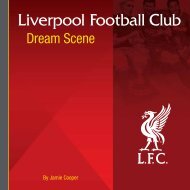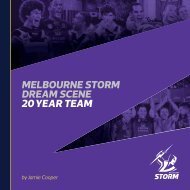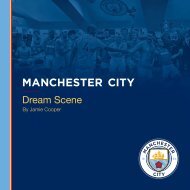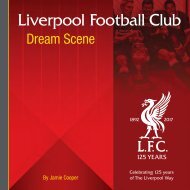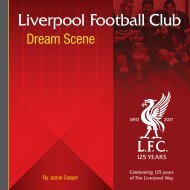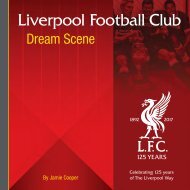You also want an ePaper? Increase the reach of your titles
YUMPU automatically turns print PDFs into web optimized ePapers that Google loves.
LEEDS UNITED<br />
CENTENARY<br />
DREAM SCENE<br />
BY JAMIE COOPER
INTRODUCTION<br />
To commemorate its 100th Anniversary, the Club commissioned<br />
renowned international sports artist Jamie Cooper, to create an iconic<br />
and truly unique artwork. His brief was to produce a defining image<br />
that captured the spirit, culture and proud history of <strong>Leeds</strong> <strong>United</strong><br />
Football Club. He has done this by bringing together 27 figures<br />
that have helped define the club, into one magical moment in time.<br />
This booklet reveals the creative inspiration and process behind the<br />
many stories woven into the <strong>Leeds</strong> <strong>United</strong> Centenary Dream Scene.<br />
IN THE ARTIST’S OWN WORDS:<br />
It is a huge challenge and responsibility to be asked to<br />
produce an artwork like this. I am greatly humbled to<br />
be entrusted to do it. As an ex-professional footballer in<br />
my homeland of Australia, I fully understand the<br />
importance of a football club to its community. The<br />
connection between fans and the Club goes way<br />
beyond the boundaries of the white lines. It is a family.<br />
So why me… an ex footballer from the other side of the<br />
world? Since retiring from my playing career I have<br />
spent 20 years honing this particular skill, creating<br />
images for professional sporting clubs in the <strong>United</strong><br />
States, Australia and Europe, where players from<br />
several generations are brought together into a Dream<br />
Scene. I painstakingly piece together 100’s of images<br />
from different times to create a believable scene where<br />
these legends live and breathe together. They interact in<br />
a moment that is surely, every fan’s Dream come true.<br />
My endeavour is to tell a story… to imagine what these<br />
characters would have said to each other, what tales<br />
they would have told and what personalities would<br />
have been drawn together in this impossible gathering.<br />
As football fans, wouldn’t we love to walk amongst<br />
them, to mingle with them as they celebrate playing<br />
the greatest game of all.<br />
Well, come with me and imagine if you will…<br />
Jamie Cooper
CROSSBAR CANNONS<br />
TONY YEBOAH<br />
1995-97 | Games: 66 | Goals: 32<br />
In 1995, striker Tony Yeboah<br />
arrived in <strong>Leeds</strong> as Howard<br />
Wilkinson smashed the club’s<br />
transfer record. It didn’t<br />
take long for fans to sit up<br />
and recognise Yeboah as a<br />
special talent with a knack for<br />
spectacular, powerful goals.<br />
Fans will always remember<br />
his thunderbolt strikes against<br />
Wimbledon and Liverpool,<br />
the latter named Goal Of The<br />
Season for 1995/96, and a<br />
stunning hat-trick in Monaco.<br />
“Three of the most dynamic forwards in the<br />
club’s history gather together to ‘discuss’<br />
who has the most potent goal scoring<br />
ability. Peter Lorimer feels his Golden Boot<br />
should settle that argument on its own, but<br />
just in case he has the stopwatch in hand<br />
to remind them of his mythical 90mph<br />
strike. Tony Yeboah is reminding them both<br />
of his Goal of the Season in 1995/96.<br />
Jermaine Beckford seems to feel pretty<br />
strongly about all this as he re-lives one<br />
of his goal celebrations. Together they<br />
represent the cream of <strong>Leeds</strong> <strong>United</strong>’s<br />
offensive power over the years.”<br />
1
THE LASH<br />
PETER LORIMER<br />
1962-78 & 1984-85 | Games: 702 | Goals: 238<br />
Regarded as having one of<br />
the hardest shots in football,<br />
Peter Lorimer still holds the<br />
record as <strong>Leeds</strong> <strong>United</strong>’s<br />
leading goal scorer. Joining<br />
the club aged just 15 years<br />
old in 1962, Lorimer became<br />
a mainstay in the late 1960s.<br />
The Scotsman was part of the<br />
1967/68 team that won the<br />
“The image of Peter Lorimer<br />
was a well-known one<br />
of him and Eddie Gray<br />
standing at the corner post.<br />
I superimposed the arms on<br />
holding the stopwatch to<br />
tell the story I needed of the<br />
90mph strike. I took some<br />
creative license switching<br />
the golden boot from his<br />
prolific right foot to his left<br />
to give it prominence.”<br />
League Cup and Inter-Cities<br />
Fairs Cup, scoring 30 goals,<br />
and the record breaking team<br />
that won the League in 1969,<br />
<strong>Leeds</strong> <strong>United</strong>’s first league title.<br />
Lorimer insisted <strong>Leeds</strong> was<br />
more than just a team, more<br />
like a brotherhood, with Don<br />
Revie as the father steering the<br />
ship to greatness.<br />
“Sometimes I am lucky<br />
enough to find a full body<br />
image that suits my purposes,<br />
as opposed to having to cut<br />
and paste headshots onto a<br />
model’s body. The image of<br />
Jermaine was taken directly<br />
from a photo of one of his<br />
goal celebrations. He seems<br />
to be perfectly reacting to the<br />
challenge set down by Peter.”<br />
A STRIKING<br />
RESEMBLANCE<br />
JERMAINE BECKFORD<br />
2006-2010 | Games: 152<br />
Goals: 85<br />
<strong>Leeds</strong> signed Beckford from<br />
non-league side Wealdstone<br />
in March 2006, when no<br />
one could have foreseen the<br />
success he enjoyed at the club.<br />
In 2008/09, Beckford scored<br />
34 goals in all competitions,<br />
the only player who could hold<br />
a candle to John Charles’ 43-<br />
goal campaign in 1953/54.<br />
Beckford’s greatest moments<br />
came in 2009/10, when<br />
he scored the only goal of<br />
a legendary FA Cup Third<br />
Round tie against Manchester<br />
<strong>United</strong> at Old Trafford,<br />
followed in May by the<br />
winning goal against Bristol<br />
Rovers that sealed promotion<br />
to the Championship.<br />
2
“Albert Johanneson was a ground breaker in English football<br />
and as such, had to overcome many hurdles to stay focused<br />
on his game. His pace and skill made him a crowd favourite<br />
in his adopted home. Despite that, he still needed some<br />
assistance to deal with the taunts and abuse from some<br />
opposition players and crowds. The entire team looked after<br />
Albert, symbolised here by his captain at the time, Bobby<br />
Collins, resting a supportive hand on his shoulder. I chose<br />
this image of Albert as it seemed to represent the great skills<br />
that made him so loved by <strong>United</strong> fans.”<br />
THE GROUND BREAKER<br />
ALBERT JOHANNESON<br />
1961-70 | Games: 200 | Goals: 68<br />
Albert Johanneson travelled<br />
from South Africa on the<br />
recommendation of a school<br />
teacher in April 1961 and<br />
made his debut for <strong>Leeds</strong> in the<br />
same month. He was joint top<br />
scorer in <strong>United</strong>’s promotion<br />
season in 1963/64, with<br />
one vital individual goal<br />
against Newcastle <strong>United</strong><br />
setting <strong>Leeds</strong> on course in<br />
the final weeks. Johanneson<br />
was widely regarded as the<br />
first footballer of colour to<br />
gain real prominence in the<br />
English professional game.<br />
He was quick, skilful and had<br />
the ability to deliver fantastic<br />
crosses. Albert formed a<br />
fantastic playing relationship<br />
with Bobby Collins who said,<br />
“Albert could fly and I could<br />
put the ball on the spot for him.<br />
When he was in his stride there<br />
weren’t many who could catch<br />
him.” Johanneson holds a club<br />
record as the only player to<br />
score two hat-tricks in European<br />
competitions, and was the<br />
first black player to play in<br />
an FA Cup Final in 1965<br />
against Liverpool.<br />
3
THE WEE BARRA<br />
BOBBY COLLINS<br />
1962-67 | Games: 167 | Goals: 26<br />
A key figure in <strong>Leeds</strong> <strong>United</strong><br />
history, experienced Scottish<br />
International Bobby Collins<br />
enjoyed success in English<br />
football with Everton before<br />
Don Revie brought him to<br />
<strong>Leeds</strong> for £25,000 in 1962.<br />
Together, Revie and Collins<br />
nurtured a group of young<br />
and talented players from the<br />
Second Division to among<br />
the best in Europe. Although<br />
Collins was small in stature,<br />
he had a huge heart and was<br />
as resilient as they come, even<br />
coming back from a broken<br />
thigh sustained against Torino<br />
in <strong>United</strong>’s first away game<br />
in Europe in 1965. His fiery<br />
determination to succeed<br />
frightened opponents and<br />
inspired teammates, setting the<br />
standard for future captain Billy<br />
Bremner to follow.<br />
“This image of Bobby was made up of<br />
three different photos. I found one with<br />
a teammate’s arm around him, but his<br />
head was looking to the right. I found<br />
another image with a nice expression<br />
looking to the left toward where Albert<br />
was to be standing. This seemed to<br />
fit the sentiment I was trying to create<br />
between the two of them. I found a<br />
pic of Bobby’s legs complete with the<br />
famous ‘off-white’ woollen socks from<br />
the 1965 FA Cup final that were in<br />
contrast to the new white nylon socks<br />
the rest of the team wore. As he was<br />
one of the tough players in a tough<br />
era that spawned the “Dirty <strong>Leeds</strong>”<br />
moniker, his gear is covered in mud.<br />
This is really a badge of honour for a<br />
man that prided himself on his intensity<br />
and commitment on the field. Note the<br />
scar on his thigh from the broken femur<br />
he suffered.”<br />
4
JOHNNY GILES<br />
1963-75 | Games: 527 | Goals: 114<br />
Irishman Johnny Giles was bought from Manchester <strong>United</strong> in<br />
1963 and made an immediate impact by helping <strong>Leeds</strong> win the<br />
Second Division title that season. When he moved in from the<br />
wing to join Billy Bremner in the heart of midfield they formed<br />
one of the greatest midfield partnerships in the game. Giles was<br />
known for his creativity, scoring just one short of Bremner’s tally<br />
with 114 goals for the club.<br />
“This again is a composite of several<br />
photos. A top half that was on the right<br />
angle to be standing next to Bobby<br />
Collins, a head shot that I wanted<br />
to be looking at Eddie Gray and his<br />
legs are actually Billy Bremner’s. He<br />
fitted perfectly alongside Giles and as<br />
a fellow scrapper on field, he is also<br />
covered in dirt. “<br />
5
“This description by Don Revie<br />
captured my imagination.<br />
So, although there is no snow in the<br />
dressing room, here he is walking<br />
through a puddle leaving<br />
no footprints. His feet are so<br />
light, he doesn’t even cast a<br />
shadow! He seems to be saying<br />
I don’t know<br />
how I do it?”<br />
THE LAST WALTZ<br />
EDDIE GRAY<br />
1965-84 | Games: 579 | Goals: 69<br />
One of the youngest of Don Revie’s homegrown players,<br />
Eddie Gray was central to the successes of the club in the<br />
1960s and 70s, and has become one of <strong>Leeds</strong> <strong>United</strong>’s<br />
most enduring figures. His pace and trickery made Gray one<br />
of the most stylish wingers the game has ever seen, with a<br />
way of ghosting across the turf and dancing past defenders<br />
that inspired Revie’s famous compliment - “When he plays<br />
on snow, he doesn’t leave any footprints.” Gray played until<br />
1984, by when he was in his first of two stints as manager.<br />
He has also served <strong>Leeds</strong> as assistant manager, youth team<br />
manager, media commentator and ambassador.<br />
6
KING JOHN<br />
JOHN CHARLES<br />
1949-57 & 1962 | Games: 327 | Goals: 157<br />
The gentle giant from Swansea<br />
began his career at <strong>Leeds</strong><br />
<strong>United</strong> in 1949 at 17 years<br />
of age, and even then it was<br />
clear to see Charles was a<br />
talent to be reckoned with.<br />
Strong, fast, good in the air<br />
and with two good feet,<br />
Charles went his entire career<br />
without picking up either a<br />
caution or a red card. As a<br />
young player he was already<br />
regarded among the world’s<br />
best at centre-half, but moving<br />
to centre-forward unleashed<br />
his skill and scoring potential,<br />
helping <strong>Leeds</strong> win promotion<br />
in 1955/56. After one season<br />
in the First Division he was<br />
sold to Juventus for £65,000,<br />
doubling the largest fee paid<br />
for a British footballer, where<br />
Charles is still regarded as<br />
their greatest ever foreign<br />
player.<br />
“My research tells me that, despite his prodigious talent, he was a shy and<br />
humble man, who really didn’t like the limelight. So here he is standing quietly in<br />
the background enjoying the scene in front of him. He has a supportive hand on<br />
the shoulder of his fellow Welshman Gary Speed and an Italian guide book in<br />
the other. This image of him was an amalgamation of several images. A happy<br />
headshot, torso and a shot of those legs. Then I placed the Italian guide book in<br />
there and a new hand on Gary Speed’s shoulder. I feel like Dr. Frankenstein!”<br />
7
LET’S GET THIS PARTY STARTED<br />
GARY KELLY<br />
1991-2007 | Games: 531 | Goals: 4<br />
Known for his jovial<br />
demeanour, Gary Kelly came<br />
to <strong>Leeds</strong> from Home Farm in<br />
Dublin, originally as a striker<br />
until the 1993/94 season<br />
when Howard Wilkinson<br />
fielded him as a right-back<br />
on the opening day against<br />
Manchester City. His pace,<br />
tenacity and competitive nature<br />
made him a nightmare for any<br />
opposition winger and one<br />
of the most reliable players in<br />
the team. He was part of the<br />
last <strong>Leeds</strong> side to play Premier<br />
League football, and enjoyed<br />
many European nights in the<br />
Champions League and UEFA<br />
Cup. His career at Elland<br />
Road spanned 16 seasons<br />
and he is the only non- Revie<br />
era player to surpass 500<br />
appearances for the club.<br />
“I felt that given<br />
his lively nature it<br />
was suitable that<br />
he helped to get<br />
the celebrations<br />
underway with<br />
a spray of<br />
champagne. I<br />
perched him up<br />
high to create a bit<br />
of variation in the<br />
line of figures.”<br />
GARY MCALLISTER<br />
1990-96 | Games: 295 | Goals: 45<br />
Howard Wilkinson took<br />
notice of Gary McAllister’s<br />
performances against <strong>Leeds</strong><br />
for Leicester City, and brought<br />
him to Elland Road in 1990<br />
for £1m. With David Batty,<br />
Gary Speed and Gordon<br />
Strachan, McAllister was<br />
part of a midfield quartet that<br />
was envied by most teams in<br />
the country. All four players<br />
complemented each other and<br />
the all-British midfield were<br />
instrumental in winning the First<br />
Division in 1992. He returned<br />
to Elland Road as manager in<br />
2008.<br />
“I thought it would be fun to have him directing the<br />
champagne towards his manager Howard Wilkinson<br />
in recognition of the success they shared.”<br />
8
“Another lively character known<br />
for his dressing room hi-jinks he<br />
completes the group of party<br />
starters. The icepack on his leg<br />
represents the nasty break he<br />
suffered during his career.”<br />
PAUL REANEY<br />
1961-78 | Games: 747 | Goals: 9<br />
‘Speedy’ Reaney was one of the mavericks of the game famous<br />
for numerous goal-line clearances. The overlapping style of<br />
full-back we now see in the modern game was pioneered by<br />
Reaney in the 1960s and 70s. His pace and athleticism meant<br />
he was delivering pin point crosses one minute, and making last<br />
ditch tackles the next. Reaney was a stalwart in Revie’s golden<br />
era at <strong>Leeds</strong> <strong>United</strong>.<br />
9
BROTHERS IN ARMS<br />
GARY SPEED<br />
1988-96 | Games: 311 | Goals: 57<br />
Gary Speed broke into <strong>Leeds</strong><br />
<strong>United</strong>’s first team during<br />
1989/90’s promotion season,<br />
scoring a memorable goal in<br />
a 4-0 rout of Yorkshire rivals<br />
Sheffield <strong>United</strong>, immortalised<br />
by the famous commentary:<br />
“Go on Gary Speed, get one<br />
yourself son.” He played in<br />
every game of <strong>United</strong>’s first<br />
season back in Division One,<br />
forming a legendary midfield<br />
alongside Gordon Strachan,<br />
Gary McAllister and fellow<br />
youngster and close friend<br />
David Batty. In 1991/92<br />
Speed helped <strong>Leeds</strong> win the<br />
league title by playing in every<br />
position except centre-half,<br />
and that versatility made him<br />
manager Howard Wilkinson’s<br />
choice for player of the title<br />
campaign. Speed played a<br />
career total 926 games for<br />
five clubs and his country, and<br />
was successfully managing<br />
Wales when he tragically died<br />
in 2011.<br />
DAVID BATTY<br />
1987-93 & 1998-2004 | Games 373 | Goals: 4<br />
David Batty was a fiercely<br />
competitive midfielder,<br />
showing flashes of his mentor,<br />
the great Billy Bremner. He<br />
was integral to the 1989/90<br />
Second Division winning side,<br />
continuing his fine form as<br />
<strong>Leeds</strong> won the First Division in<br />
1992. While protecting the<br />
defence by fighting tenaciously<br />
for the ball, Batty had vision<br />
and skill to start attacks with<br />
incisive passing. He returned<br />
to <strong>Leeds</strong> in 1998, providing<br />
experience to guide David<br />
O’Leary’s young team, and<br />
forming a strong midfield<br />
partnership with Olivier<br />
Dacourt as <strong>Leeds</strong> reached the<br />
semi-finals of the Champions<br />
League.<br />
“I feel that these two great friends<br />
embody the spirit of <strong>Leeds</strong> <strong>United</strong>. I<br />
wanted to make them the centre-piece<br />
of the painting. Talented, committed<br />
and passionate, they are depicted<br />
giving the <strong>Leeds</strong> salute in recognition<br />
of the community culture and family<br />
spirit of this great club.”<br />
10
DYNAMIC DUO<br />
ALLAN ‘SNIFFER’ CLARKE<br />
1969-75 | Games: 367 | Goals: 151<br />
MICK JONES<br />
1967-75 | Games: 313 | Goals: 111<br />
In the summer after <strong>Leeds</strong> won<br />
their first ever title in 1969,<br />
Don Revie paid Leicester City<br />
£165,000 for 23-year-old<br />
Allan Clarke to strengthen<br />
<strong>Leeds</strong>’ attack. Clarke will<br />
always be remembered for<br />
the centenary FA Cup Final<br />
against Arsenal in 1972,<br />
when Mick Jones crossed and<br />
Clarke executed a perfect<br />
diving header to win the cup<br />
for the first time in <strong>United</strong>’s<br />
history. Known as ‘Sniffer’ on<br />
the terraces, Clarke was one<br />
of only a handful of players<br />
Revie bought from outside<br />
Elland Road, becoming a<br />
close friend to Billy Bremner<br />
and one of <strong>United</strong>’s greatest<br />
ever strikers.<br />
“This one was dead easy to decide on. I’ve recreated that<br />
famous day in 1972 by adopting poses for these guys that<br />
all LUFC fans will recognise. Clarke is wearing the FA Cup<br />
lid, and Jones wears makeshift arm bandages for his elbow.<br />
Clarke’s arm round Jones is in thanks for that famous match<br />
winning cross. It also symbolises the many times that they<br />
worked together to create goal scoring opportunities.”<br />
Mick Jones became <strong>Leeds</strong><br />
<strong>United</strong>’s first £100,000<br />
signing when Don Revie<br />
bought him from Sheffield<br />
<strong>United</strong> in 1967, and the<br />
new striker helped lift <strong>Leeds</strong><br />
from among the best teams in<br />
England, to become a club<br />
winning trophies at home<br />
and abroad. When he was<br />
joined by Allan Clarke, Jones’<br />
strength was complemented by<br />
Clarke’s skill, a combination<br />
that brought the best out of<br />
them both. After crossing to<br />
Clarke to head the winner in<br />
the 1972 FA Cup final, Jones<br />
ended the match in agony<br />
after dislocating his elbow in<br />
the final moments. Although<br />
Mick Bates had collected his<br />
medal for him, Jones insisted<br />
on climbing the famous<br />
Wembley steps himself,<br />
helped by Norman Hunter, to<br />
shake hands with the Queen.<br />
“Allan holds Les<br />
Cocker’s tracksuit<br />
in the air in respect<br />
to the legendary<br />
trainer, who<br />
famously carried<br />
him from the field<br />
on his shoulders<br />
one day.”<br />
11
“From one end of<br />
the club’s timeline<br />
to the other. These<br />
two club captains<br />
depicted together<br />
symbolise what<br />
the Dream Scene<br />
is all about. The<br />
unification of the<br />
entire 100-year<br />
history of this proud<br />
club. Edwards hands<br />
his captain’s arm<br />
band to Cooper.”<br />
FROM ONE END TO THE OTHER<br />
LIAM COOPER<br />
2014 – Present | Games up to end of 2018/19 season: 161 | Goals: 6<br />
The captain of Marcelo<br />
Bielsa’s <strong>Leeds</strong>, Liam Cooper<br />
epitomises what it is to play for<br />
<strong>Leeds</strong> <strong>United</strong>. A hard-working<br />
player who leads by example,<br />
Cooper is at the forefront as<br />
WILLIS EDWARDS<br />
1925-43 | Games: 444 | Goals: 6<br />
we move into a new era. The<br />
Yorkshire-born defender joined<br />
<strong>Leeds</strong> in 2014 and was voted<br />
captain by the players at the<br />
start of 2017/18. A crowd<br />
favourite in LS11, Cooper’s<br />
passion for taking <strong>Leeds</strong> back<br />
to the upper echelons of<br />
English football shines through<br />
in every performance.<br />
Willis Edwards moved to<br />
<strong>Leeds</strong> from Chesterfield for a<br />
big fee of £1,500 in 1925,<br />
with the reputation of being<br />
one of the finest wing halves<br />
of his generation. He became<br />
the club’s first international<br />
when he played for England<br />
against Wales at Selhurst Park<br />
in 1926, and was rarely out<br />
of the <strong>Leeds</strong> side up until the<br />
start of the Second World<br />
War in 1939. His magnificent<br />
ball control, athleticism,<br />
heading ability and passing<br />
quality earned him 16 caps<br />
for his country, as well as 11<br />
appearances for the Football<br />
League, and Edwards had<br />
a season as manager in<br />
1947/48, staying on the<br />
<strong>Leeds</strong> coaching staff until<br />
1961.<br />
12
“Nigel enters the room holding Lulu the<br />
Doll which he found in the back of the<br />
net. It must have been left there since the<br />
1950s where it was placed as a good<br />
luck charm by Harry Searson in 1949.<br />
But he still needs to get around big Jack<br />
who is up to his old tricks blocking goal<br />
keepers from moving about!”<br />
LAST LINE OF DEFENCE<br />
NIGEL MARTYN<br />
1996-2003 | Games: 273<br />
One of the finest goalkeepers<br />
the Premier League and<br />
England national team have<br />
ever seen, Nigel Martyn<br />
played over 250 times for The<br />
Whites, who signed him for<br />
a record fee for a goalkeeper<br />
of £2.25 million in 1996. In<br />
six seasons with <strong>Leeds</strong>, Martyn<br />
was a major part of the club’s<br />
rise to the top of the Premier<br />
League and the semi-finals of<br />
the Champions League, when<br />
David O’Leary’s young players<br />
knew that they had a world<br />
class goalkeeper behind them<br />
all the way.<br />
13
GREAT MINDS<br />
SERGEANT WILKO AND THE DON.<br />
HOWARD WILKINSON<br />
Manager 1988-96<br />
Originally hailing from<br />
Sheffield, Howard Wilkinson<br />
left Sheffield Wednesday to<br />
take over <strong>Leeds</strong> in 1988,<br />
when the club was struggling<br />
near the bottom of the Second<br />
Division. Soon known as<br />
Sergeant Wilko, he brought<br />
in strict fitness regimes and<br />
instilled discipline, as well<br />
as bringing in quality players<br />
from the First Division like Chris<br />
Fairclough, Vinnie Jones, Lee<br />
Chapman, and his captain,<br />
Gordon Strachan. <strong>Leeds</strong><br />
started the 1989/90 season<br />
with a weight of expectation<br />
and anticipation unlike any the<br />
club had known for years, and<br />
ended it as Second Division<br />
champions. <strong>United</strong>’s upward<br />
momentum took them all the<br />
way to a famous First Division<br />
title in 1991/92, when they<br />
beat fierce rivals Manchester<br />
<strong>United</strong> to win the league, and<br />
Wilkinson’s record included<br />
winning the Charity Shield,<br />
reaching the League Cup<br />
final and twice qualifying for<br />
Europe. Perhaps Wilkinson’s<br />
biggest legacy is the youth<br />
academy he established at<br />
Thorp Arch, ensuring a steady<br />
supply of top class talent that<br />
<strong>Leeds</strong> <strong>United</strong> have benefited<br />
from for 25 years.<br />
“There was so much to work with regarding these two<br />
great managers. Wilko has finally agreed to put the Revie<br />
Era photographs back on the wall now that they have won<br />
a title. In Wilko’s first press conference he was offered a<br />
coffee cup with no handles and said, “I hope when we’re<br />
doing well we can afford cups with handles on,” and that’s<br />
his reward from Revie.”<br />
14
DON REVIE<br />
Manager 1961-75<br />
The Middlesbrough-born<br />
manager who changed the<br />
fortunes of <strong>Leeds</strong> <strong>United</strong> and<br />
created the club as we know<br />
it today.<br />
Don Revie came to Elland Road<br />
as an experienced forward<br />
in November 1958 near the<br />
end of his playing career.<br />
With <strong>Leeds</strong> struggling in the<br />
Second Division in 1961,<br />
director Harry Reynolds was<br />
about to recommend Revie<br />
as manager to Bournemouth,<br />
when he realised he should<br />
be recommending he become<br />
manager of <strong>Leeds</strong>. With the<br />
support of his clever backroom<br />
staff, Revie set about changing<br />
<strong>Leeds</strong> <strong>United</strong>’s fortunes,<br />
creating the club as we know<br />
it. He put his faith in schoolboy<br />
players like Norman Hunter,<br />
Eddie Gray, Paul Reaney,<br />
Paul Madeley, Peter Lorimer<br />
and Gary Sprake, entrusting<br />
them to the more experienced<br />
Jack Charlton and new<br />
signings Bobby Collins and<br />
Johnny Giles; Billy Bremner,<br />
a young winger and already<br />
Revie’s protégé, became the<br />
inspiration of the team. Under<br />
Revie’s leadership <strong>Leeds</strong> won<br />
the First Division twice, the Inter-<br />
Cities Fairs Cup twice, the FA<br />
Cup, League Cup and Charity<br />
Shield, as well as finals, semifinals<br />
and 2nd place finishes<br />
during ten years when <strong>Leeds</strong><br />
were among the most talked<br />
about teams in football. Above<br />
all, Don made all his players<br />
feel welcome in the dressing<br />
room. No matter what age,<br />
experience, background or<br />
creed, he was the father figure<br />
to this glorious team in the all<br />
white strip that he introduced.<br />
You run out of superlatives<br />
for Don. He was simply the<br />
greatest we’ve ever had.<br />
“Don himself was a unique character and offered me a lot of<br />
material to celebrate his ‘funny ways’. Being a superstitious<br />
man he is wearing his ”lucky” blue suit. He employed the<br />
services of Gypsy Rose Lee to remove bad luck from the club,<br />
and is holding her pretend business card “Curses are Us”.<br />
Here he also holds a get-well card for one of the player’s<br />
family members, and the red book from when he featured on<br />
‘This Is Your Life’ in 1974 in recognition of his contribution to<br />
English Football.”<br />
15
THE SECRETS OF SUCCESS<br />
NORMAN HUNTER<br />
1961-76 | Games: 726 | Goals: 21<br />
Norman Hunter, like many<br />
of the club’s great players,<br />
came to <strong>Leeds</strong> when he was<br />
just a teenager, and a slender<br />
midfield player. After intensive<br />
training from Les Cocker and<br />
Syd Owen, Hunter became<br />
a fearsome defender with the<br />
nickname ‘Bites Your Legs’,<br />
but he never lost his good<br />
nature, despite his reputation.<br />
Hunter is one of the club’s<br />
most decorated players,<br />
winning six trophies for <strong>Leeds</strong><br />
and featuring in the World<br />
Cup winning squad in 1966.<br />
Although Hunter was often<br />
modest about his footballing<br />
prowess, his ability was<br />
recognised by fellow players<br />
in 1974 when he was the first<br />
ever winner of the Professional<br />
Footballers’ Association<br />
‘Players’ Player Of The Year<br />
Award’.<br />
“When Norman arrived at<br />
the club, Don felt he needed<br />
a little strengthening up. So<br />
what better remedy than a<br />
daily dose of a raw egg in<br />
a glass of sherry? They were<br />
different days back then!”<br />
GORDON STRACHAN<br />
1989-95 | Games: 245 | Goals: 45<br />
Gordon Strachan was<br />
Howard Wilkinson’s most<br />
important signing, when he<br />
convinced the Scotsman to<br />
drop down a division to join<br />
him at Elland Road. Wilkinson<br />
calculated that Strachan’s<br />
medals, and his experiences<br />
at the 1986 World Cup,<br />
would set an example for the<br />
other players; and that his<br />
determined personality would<br />
ensure they followed.<br />
He captained <strong>Leeds</strong> to the<br />
Second Division and First<br />
Division titles in three seasons,<br />
taking the club back into<br />
Europe as part of <strong>United</strong>’s<br />
famous midfield with David<br />
Batty, Gary McAllister and<br />
Gary Speed. In 1991 he<br />
won the Football Writers’<br />
Association Footballer of the<br />
Year award, the only player to<br />
have won it in both England<br />
and Scotland.<br />
“I’ve depicted him in the<br />
promotion year of 1989/90.<br />
Although he had success<br />
in Division One, he always<br />
felt that getting the club up<br />
from Division Two was his<br />
most satisfying achievement.<br />
Gordon also apparently had<br />
a secret weapon.”<br />
“Was it his banana and<br />
seaweed pills that gave him<br />
the longevity and success<br />
during his time at the club? ”<br />
16
ELEVEN PAULS<br />
33<br />
“A Bentley’s Brewery<br />
Yorkshire Bitter of course!”<br />
34<br />
“He’s even had time to<br />
read the paper. The 1956<br />
Evening Post featuring the<br />
West Stand fire.”<br />
36<br />
PAUL MADELEY<br />
1962-80 | Games: 725<br />
Goals: 34<br />
Paul Madeley was one of<br />
the most versatile players the<br />
game has ever seen, playing<br />
for <strong>Leeds</strong> in every position<br />
apart from goalkeeper. Don<br />
Revie always denied any<br />
idea of Madeley ‘filling in’,<br />
or that he was a ‘super sub’,<br />
and the enormous number of<br />
appearances he made prove<br />
that Revie always found a<br />
place for Madeley in his team,<br />
while 24 caps demonstrate<br />
his importance to England.<br />
Raised just a few miles from<br />
Elland Road, Madeley was<br />
an exemplary member of the<br />
club’s greatest ever team, and<br />
his long-range strike away to<br />
Juventus in 1971 was vital to<br />
<strong>United</strong>’s victory in the Inter-<br />
Cities Fairs Cup.<br />
“I’ve put him in the Inter-Cities<br />
Fairs Cup kit, holding the trophy<br />
in recognition of his away goal v<br />
Juventus, which was so important<br />
in that successful campaign. Being<br />
a modest chap I thought that it was<br />
apt he be sitting back enjoying the<br />
scene in front of him. I also felt he<br />
deserved to be putting his feet up<br />
and having a beer after such a<br />
long and distinguished career.”<br />
“The white rose of Yorkshire<br />
is in his shirt pocket in<br />
his locker.”<br />
17
THE CHIEF<br />
LUCAS RADEBE<br />
1994-2005 | Games: 262 | Goals: 3<br />
It took a while for Radebe<br />
to establish himself at <strong>Leeds</strong><br />
after he joined from one<br />
of South Africa’s top clubs,<br />
Kaizer Chiefs, in 1994, but<br />
he blossomed as a central<br />
defender after George<br />
Graham became manager.<br />
By the time David O’Leary<br />
took over Radebe was<br />
captain, soon regarded as<br />
one of the best defenders<br />
in Europe. Nicknamed The<br />
Chief, Radebe captained<br />
South Africa at the 1998 and<br />
2002 World Cup, and was<br />
described by President Nelson<br />
Mandela as, ‘My hero’. In<br />
2000 he received the FIFA<br />
Fair Play award for his role<br />
in fighting racism in football.<br />
Although he didn’t acquire<br />
any titles in his time at <strong>Leeds</strong>,<br />
Radebe’s manner, playing<br />
style and character are never<br />
forgotten by the <strong>Leeds</strong> <strong>United</strong><br />
faithful.<br />
“Behind every great midfield is a solid defence. Lucas<br />
Radebe was known for his reliability at the back<br />
so I thought it fitting he was positioned behind the<br />
foreground group looking over their shoulder. He is also<br />
joining in the celebrations clinking a bottle of Radebeer<br />
with Billy’s champers!”<br />
HOW GOOD IS THIS?<br />
MARK VIDUKA<br />
2000-04 | Games: 166 | Goals: 72<br />
Mark Viduka was much<br />
travelled, from Australia to<br />
Croatia Zagreb to Celtic,<br />
before he signed for <strong>Leeds</strong><br />
in 2000. A strong striker,<br />
Viduka was deceptively skilful,<br />
and he formed a formidable<br />
partnership with his tigerish<br />
young foil Alan Smith.<br />
Viduka’s backheel set Smith<br />
up to score an audacious<br />
winner against Lazio in the<br />
Champions League, while<br />
his own goalscoring highlight<br />
came against Liverpool, when<br />
he scored all four of <strong>United</strong>’s<br />
goals in a 4-3 win at Elland<br />
Road. Viduka’s power as<br />
a finisher made him one of<br />
<strong>United</strong>’s best strikers of the<br />
modern era.<br />
“This image of Big Dukes v Besiktas is iconic and made<br />
a great contrast with all the figures looking back at<br />
him and us. Apart from it being a dynamic and very<br />
recognisable image of him it’s as if he’s saying “how<br />
good is this?”, inviting us to acknowledge the wonderful<br />
scene in front of us.”<br />
18
OUR CAPTAIN<br />
BILLY BREMNER<br />
1959-76 | Games: 772 | Goals: 115<br />
Billy Bremner holds the title of<br />
<strong>Leeds</strong> <strong>United</strong>’s most successful<br />
ever captain. He joined <strong>Leeds</strong><br />
<strong>United</strong> when he was only<br />
17 years old, playing his<br />
first games on the wing, with<br />
Don Revie guiding him from<br />
inside-right. Revie’s influence<br />
continued after he became<br />
manager, and Bremner<br />
became not only the captain<br />
but the heart of <strong>United</strong>’s<br />
greatest ever team. Bremner<br />
embodied everything it means<br />
to be <strong>Leeds</strong>: courage, passion,<br />
hard work and a never-saydie<br />
attitude. He instilled<br />
those values, and his belief<br />
in ‘Side Before Self, Every<br />
Time’ is written across the<br />
stadium entrance to this day.<br />
Bremner almost took <strong>Leeds</strong><br />
back to glory as manager<br />
in 1986/87. As captain<br />
Bremner won two First Division<br />
titles, two Inter-Cities Fairs<br />
Cups, one FA Cup and one<br />
League Cup. A record that<br />
future <strong>Leeds</strong> <strong>United</strong> captains<br />
will find hard to beat.<br />
“Billy had to be front and centre in this<br />
painting. Apart from being a huge talent,<br />
he was renowned for his determination and<br />
tenacity which made him a tough and truly<br />
great leader. So I thought he should be covered<br />
in mud and sweat after giving it his all out on<br />
the pitch. He’s also perched on top of Bielsa’s<br />
blue bucket and true to form is sharing a<br />
cigarette with his old mate Jack Charlton.”<br />
19
24<br />
SALEM CHAPEL / LEEDS UNITED SUPPORTERS CLUB<br />
BIG JACK<br />
<strong>Leeds</strong> <strong>United</strong> were formed at a public meeting held at Salem<br />
Chapel on 17th October 1919. <strong>Leeds</strong> <strong>United</strong> Supporters Club<br />
formed the very same day and share their 100 Year birthday with<br />
the club.<br />
JACK CHARLTON<br />
1952-73 | Games: 773 | Goals: 96<br />
Jack Charlton was a one club<br />
man who didn’t truly realise<br />
his potential until after Don<br />
Revie became manager. At<br />
first Charlton resisted Revie’s<br />
ideas, but persistence paid<br />
off. Revie told Charlton he<br />
could play for England, and<br />
he did, making his debut aged<br />
29, winning the 1966 World<br />
Cup at Wembley a year later.<br />
His partnership with Norman<br />
Hunter in the centre of defence<br />
was the foundation for much<br />
of <strong>Leeds</strong> <strong>United</strong>’s success, and<br />
their performance together in<br />
a 0 -0 draw with Liverpool at<br />
Anfield in 1969 sealed the<br />
club’s first league title. Jack<br />
retired in 1973 with 773<br />
appearances to his name - a<br />
<strong>Leeds</strong> <strong>United</strong> record that still<br />
stands to this day.<br />
BREMNER’S SOCK TAG<br />
One of the many creative<br />
ideas Paul Trevillion introduced<br />
to ‘rebrand’ the club, the<br />
numbered sock tags (1-12)<br />
were first used in the 1971-72<br />
season. They became firm<br />
folklore favourites with the fans.<br />
COOPER’S BOOK OF DREAMS<br />
Left–back Terry Cooper scored<br />
the winning goal in the 1968<br />
League Cup Final. He later<br />
confessed to dreaming about<br />
scoring that goal for three<br />
nights in succession before the<br />
final. His reknowned white<br />
football boots sit close by.<br />
“As the club’s appearance record holder he also had to<br />
take a central role in the painting. So here he is next to Billy<br />
having a celebratory cigarette. He is also holding a hand<br />
up blocking the movement of yet another goalkeeper! He was<br />
famous for inventing this tactic in games where he stood next<br />
to keepers when a corner was taken to open up the goal area<br />
for his teammates.”<br />
FIRST GAME<br />
<strong>Leeds</strong> <strong>United</strong>’s first ever game at Elland Road was on 17th<br />
November 1919 against Yorkshire Amateurs. <strong>United</strong> won 5-2.<br />
20
27<br />
‘KEEP FIGHTING’<br />
The sign with the club’s well known philosophy hung up in the players’<br />
dressing room at Elland Road in the late 1950s. It was the idea of<br />
trainer/coach Bill Lambton.<br />
Steelworks. Efforts to establish football in <strong>Leeds</strong> in the 1880s were<br />
against the backdrop of the enormous steelworks in Hunslet. Coining<br />
the nickname ‘the Twinklers’ in reference to the twinkling particles of<br />
‘kish dust’ that were impossible to clean from the steelworkers’ skin,<br />
Hunslet AFC ultimately paved the way for the ‘one football club city’<br />
that was to come.<br />
WANTED POSTER<br />
The two European Finals were<br />
so controversially refereed, the<br />
match officials are depicted as<br />
being on the public enemy list for<br />
‘Crimes Against Football’.<br />
SOLDIER WILSON / £5 NOTE /<br />
HILTON CROWTHER<br />
David Wilson – a 23 year-old<br />
forward for <strong>Leeds</strong> City and Boer<br />
War veteran - died of a heart<br />
attack at Elland Road during a<br />
game in 1906. The inquest stated<br />
‘his devotion to the game and to<br />
the club proved fatal.’<br />
Chairman Hilton Crowther<br />
bankrolled <strong>United</strong>’s first<br />
promotion, then was forced to<br />
call in his loan. The fans’ ‘Lend<br />
Us A Fiver’ campaign saved the<br />
club, while Hilton married famous<br />
actress Mona Vivian soon after.<br />
GHOST TROPHIES<br />
DIAMOND FLOODLIGHTS<br />
SILVER’S PAINT<br />
CHEESE WEDGE<br />
Robbed of winning glory at<br />
both the 1973 European Cup<br />
Winners Cup Final in Greece<br />
and the 1975 European Cup<br />
Final in Paris, the shadows depict<br />
the missing silverware from the<br />
trophy cabinet. The 1975 Final is<br />
the origin of the WACCOE chant.<br />
The iconic diamond-shaped<br />
floodlights were installed in<br />
1973. Towering over Elland Road<br />
at 260 feet high, they were the<br />
tallest in Europe at the time and<br />
remained in place until 1992.<br />
A nod to club Chairman Leslie<br />
Silver, founder of the Silver<br />
Paint & Lacquer Co empire and<br />
responsible, together with Director<br />
Bill Fotherby, for persuading<br />
Howard Wilkinson to come to<br />
Elland Road in the 1980s.<br />
The South East Corner Stand at<br />
Elland Road has yellow seats as<br />
opposed to the usual blue. It has<br />
affectionately become known as<br />
the ‘cheese wedge.’<br />
21
OFFICIAL LICENSED PRODUCT


